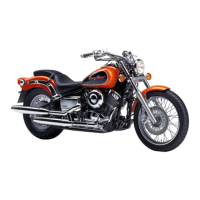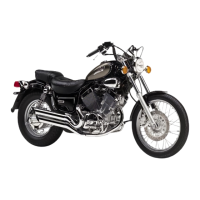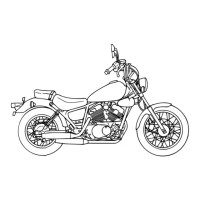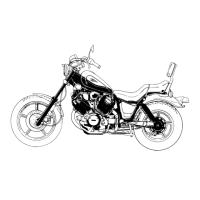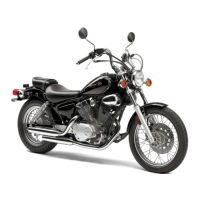
Do you have a question about the Yamaha 1997 Virago XV535J and is the answer not in the manual?
| Year | 1997 |
|---|---|
| Manufacturer | Yamaha |
| Model | Virago XV535J |
| Category | Motorcycle |
| Displacement | 535 cc |
| Compression Ratio | 9.0:1 |
| Transmission | 5-speed |
| Final Drive | Shaft |
| Front Suspension | Telescopic fork |
| Rear Suspension | Dual shocks |
| Front Brake | Single disc |
| Rear Brake | Drum |
| Front Tire | 100/90-19 |
| Rear Tire | 140/90-15 |
| Engine Type | V-twin |
| Bore x Stroke | 76 x 59 mm |
| Fuel System | Carburetor |
| Fuel Capacity | 12 liters |
| Ignition | Transistor Controlled Ignition (TCI) |
Explains safety alert symbols, warnings, and cautions used in the manual.
Essential requirements and techniques for safe motorcycle operation.
Recommends wearing appropriate protective gear for rider safety.
Guidelines for safely adding cargo or accessories to the motorcycle.
Precautions related to gasoline flammability and exhaust fumes.
Identifies and illustrates key parts of the motorcycle.
Instructions for recording key identification numbers for reference.
Location and purpose of VIN and model label for parts and registration.
Operation of main switch, indicators, and handlebar controls.
Functionality of engine stop, hazard, and fuel reserve switches.
Operation of the clutch lever and shift pedal.
Operation of front/rear brakes and fuel tank cap.
Operation of choke, steering lock, seat access, and helmet holder.
Adjusting rear shock preload and sidestand operation.
Procedure to check sidestand and clutch switch functionality.
Inspecting brakes, clutch, fluid levels, and free play.
Checking throttle, engine oil, and final gear oil levels.
Checking tire pressure, wheel condition, chassis fasteners.
Inspecting lights, switches, battery, and fuel level.
Understanding controls and safe operation regarding exhaust fumes.
Importance of sidestand retraction and starting a cold engine.
Procedures for starting a warm engine and changing gears.
Guidelines for breaking in the engine for optimal performance and longevity.
Safe procedures for parking the motorcycle, considering hot components.
Summary of recommended maintenance intervals and tasks.
Procedures for draining and replacing engine oil and filter.
Procedures for checking and replacing final gear oil.
Instructions for cleaning or replacing the air filter.
Adjusting carburetors, inspecting spark plugs, and valve clearance.
Adjusting brakes, checking wear, and replacing brake fluid.
Adjusting clutch lever, lubricating cables, pedals, and levers.
Inspecting forks, steering, sidestand, and servicing battery.
Replacing fuses and headlight bulbs.
Procedures for front/rear wheel service and bearing checks.
A guide to diagnosing and resolving common motorcycle issues.
Detailed steps for washing and drying the motorcycle.
Steps to prepare the motorcycle for storage to prevent deterioration.
Specifications for overall dimensions, weight, and engine details.
Specifications for transmission, chassis, and tire sizes.
Specifications for brakes, suspension, electrical systems, and lighting.



